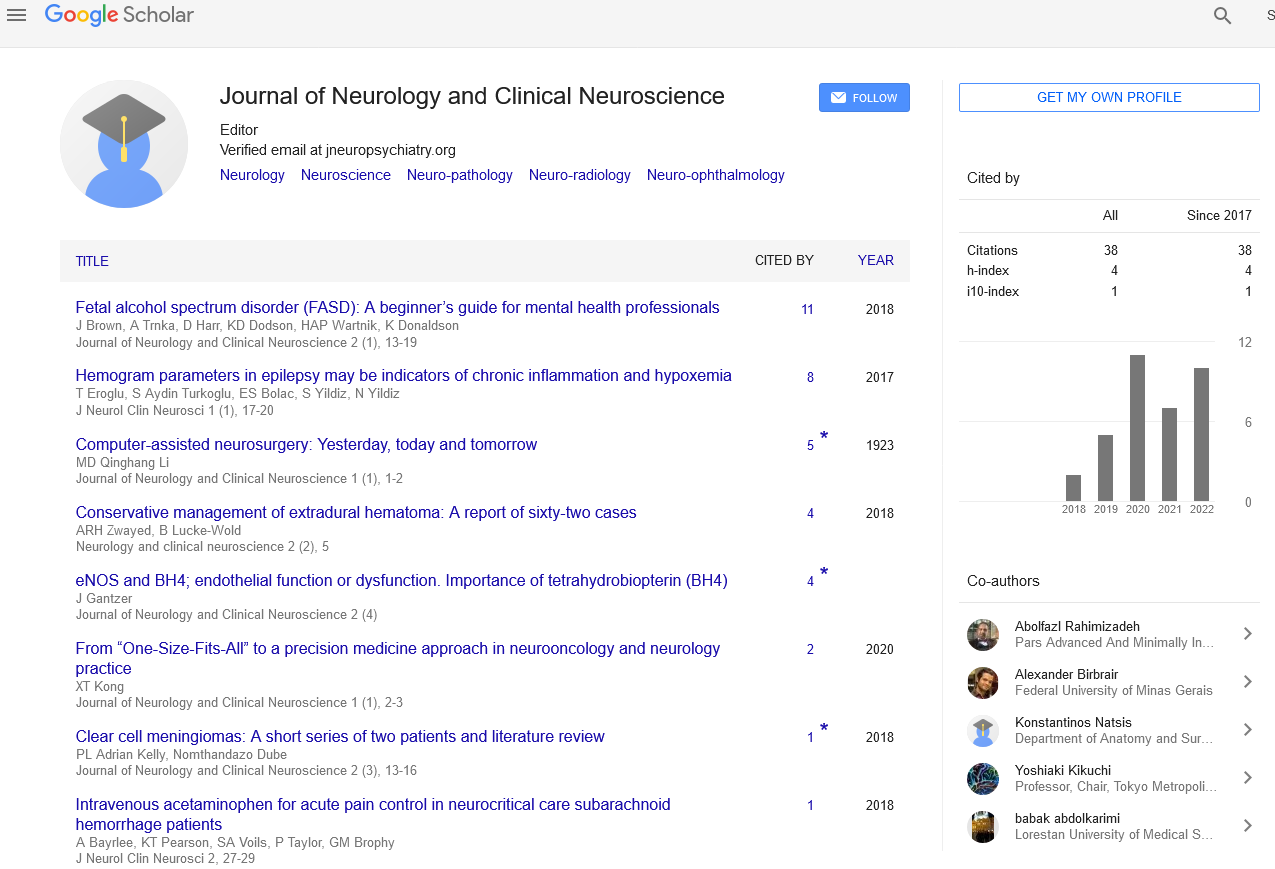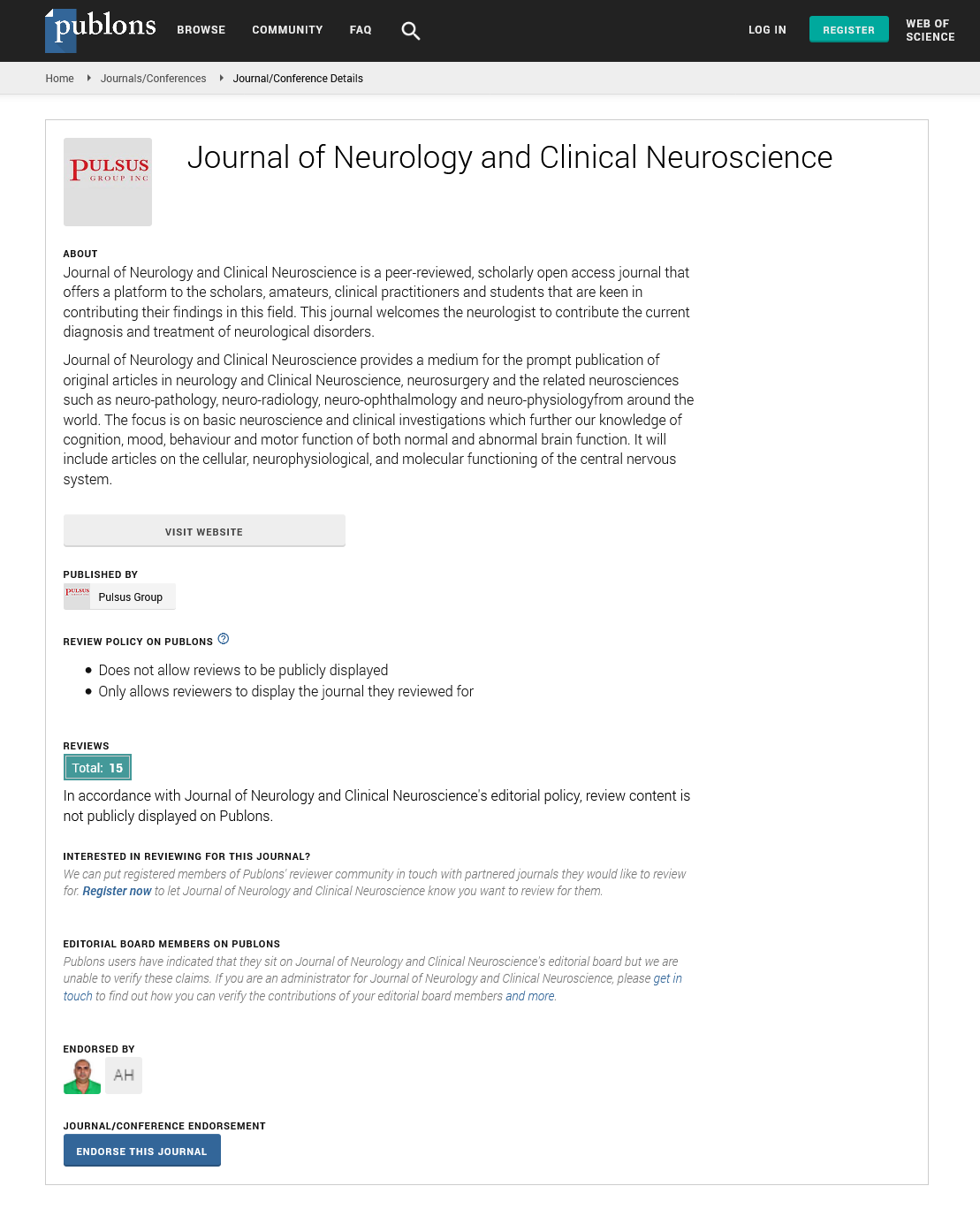COVID-19 and stroke: A mini review
Received: 01-Mar-2021 Accepted Date: Mar 15, 2021; Published: 22-Mar-2021
Citation: Solomon AS. COVID-19 and Stroke: A Mini Review. J Neurol Clin Neurosci. 5(1):2-3.
This open-access article is distributed under the terms of the Creative Commons Attribution Non-Commercial License (CC BY-NC) (http://creativecommons.org/licenses/by-nc/4.0/), which permits reuse, distribution and reproduction of the article, provided that the original work is properly cited and the reuse is restricted to noncommercial purposes. For commercial reuse, contact reprints@pulsus.com
Abstract
Corona viruses affect not only the respiratory system but also many other human systems, including the coagulation and gastro-intestinal systems, as well as the kidneys, eyes, heart and liver. Recent literature reveals that traces of the virus can even be found in the brain or cerebrospinal fluid. The literature presents a wide range of neurological diseases created by COVID-19. We present here the major studies conducted to understand the correlation between COVID-19 and the many rise in cases of stroke reported worldwide.perforation
Keywords
COVID-19; Stroke; Neurology
Introduction
Medical literature regarding the COVID-19 pandemic is rapidly accumulating. At the beginning of the pandemic, severe acute respiratory syndrome (SARS) was the primary sign of the disease. Yet we have come to recognize the multiplicity of symptoms created by this virus, as well as the variance of the diseases in assaults on almost all the human organic systems and their seemingly unlimited severity. The present review of five key studies focuses on the wide range of neurological disorders created by COVID-19. The reports cited here cover all the aspects of diagnosis, symptoms and outcome of the disease.
Microbleeds
The medical approach to treating hospitalized patients with moderate to severe cases of COVID-19 has included computerized tomography (CT) or magnetic resonance imaging (MRI). A study conducted at three hospitals in New York City investigated the prevalence and distribution of cerebral microbleeds and leukoencephalopathy in hospitalized patients with COVID-19 and their correlation with clinical, laboratory and functional outcomes [1]. Through this retrospective chart review of 4,131 COVID- 19-positive adults, physicians evaluated the MRIs in detail and identified a subset of patients with leukoencephalopathy and/or microbleeds. The researchers compared clinical, laboratory and functional outcomes for these patients with those of patients who had a brain MRI that did not show this condition. All the patients with MRI findings of leukoencephalopathy and/ or microbleeds were clinically sicker at the time of brain MRI (with a median GCS of 6 versus 14, p<0.001). They required longer ventilation support (34.6 days versus 9.1 days; p<0.001) their SARS score was higher (88.6% versus 23.8%; p<0.001). These patients also had longer hospitalizations (42.1 versus 20.9 days; p<0.001) and a higher mortality rate (20% versus 9%). The conclusion of this study is that presence of cerebral microbleeds and/or leukoencephalopathy is associated with critical illness, increased mortality, and worse functional outcome in patients with Covid-19.
Age and Stroke
General consensus holds that the high risk of severe SARS leads to high mortality for people above the age of 65–70 years. However, as the pandemic progresses, it seems that this criterion is not clear. Recent reports about patients with severe conditions note younger people who died or needed long-term ventilation. A case study of adults below 55 years of age who suffered strokes was published June 2020 [2]. Six COVID-19 patients younger than 55 years were evaluated for symptoms, laboratory data, imaging results and disease outcomes from early March 2020 to the end of April 2020. All stroke cases were hospitalized in a tertiary academic hospital. Patients who had evidence of cardiac problems such as arrhythmia or previous surgery were excluded. Fever, myalgia, cough and dyspnea were the most common symptoms. CT presented that the most involved was the middle cerebral artery (MCA) in five cases and the basal ganglia in one. The lung condition was poor in all patients, with a mean lung function score of just over 13 out of 24 (SD 6.4). It is known today that COVID-19 has in impact on the coagulation process and creates micro-thrombosis in the whole vascular system, including the brain. COVID-19 predisposes the patient to venous and arterial thrombo-embolism, leading to diffuse intravascular coagulation. This condition can appear also in patients younger than 60 years.
Covid-19 and Acute Ischemic Stroke
Stroke as a presentation has not been strongly associated with COVID-19. A retrospective case-control study was conducted to examine a potential link between COVID-19 and acute stroke [3]. The study involved patients who underwent stroke alert imaging, resulting in confirmed acute stroke, during the period of mid-March and early April, 2020. Subjects were 41 COVID- 19-positive patients and 82 control subjects matched by age, sex, and risk factors, from six hospitals across New York City. Control subjects were those who underwent stroke alert imaging during same timeframe without results revealing evidence of acute infarction. The mean age for cases and controls was 65.5 -+ 15.3 years and 68.8+- 13.2 years, respectively. Of patients with acute ischemic stroke, 46.3% had COVID-19 infection, compared with 18.3% of controls (p=0/001). After adjusting for age, sex, and risk factors, COVID-19 infection had a significant independent association with acute ischemic stroke compared with control subjects. The authors conclude that COVID-19 infection is significantly associated with imaging confirmation of acute ischemic stroke, and patients with COVID-19 should undergo more aggressive monitoring of stroke.
Neuropathological Features of Covid-19
The first cases series published by New England Journal of Medicine includes a report by Isaac H. Solomon from Brigham and Women’s Hospital, Boston, Massachusetts and colleagues [4]. The study presents the results of autopsies performed in a uniform manner on 18 patients who died between 0 and 32 days, after the onset of COVID-19 symptoms. In all cases, the specimens showed only hypoxic changes in the brain tissue but did not reveal encephalitis or other specific brain changes. Gross inspection demonstrated atherosclerosis in 14 brain specimens but not acute stroke, hernation, or olfactory bulb damage. Microscopic examination showed acute hypoxic injury in the cerebrum and cerebellum in all patients, with loss of neurons in the cerebral cortex, hippocampus, and cerebellar Purkinje cell layer, but no thrombi or vasculitis. The virus was detected at low levels in six brain sections obtained from five patients; these levels were not consistently related to the interval from the onset of symptoms to death. Positive tests may have been due to in situ virions or viral RNA from blood. According to a retrospective chart review by neurologists, all patients had a confused state or decreased arousal from sedation for ventilation (61% received mechanical ventilation). The authors conclude that the main and total pathology of the brain, in all cases, was severe hypoxic changes.
The Emerging Spectrum of Covid-19 Neurology
A COVID-19 study group of 57 authors from UK representing 12 different institutions published an article resulting from a multi-disciplinary neurology meeting at the National Hospital, Queen Square, in early March 2020 to discuss and begin to understand neurological presentations in patients with suspected COVID-19–related neurological disorders [5]. The article reports on 43 patients, 29 of whom were COVID-19-positive and definite, eight probable, and six possible. Five major symptom categories emerged among patients: a) encephalopathies (n=10) with delirium/psychosis and no distinct MRI or CSF abnormalities, nine out of ten of which made full or partial recovery with supportive care only. b) Inflammatory CNS syndrome (n=12) including encephalitis (n=6) para- or post-infectious); acute disseminated encephalomyelitis (n=9) with hemorrhage in five, necrosis in one, and myelitis in two and isolated myelitis in one. Of all patients in this category, ten were treated with corticosteroids and three also received intravenous immunoglobulin. Ultimately, one made a full recovery, ten made a partial recovery, and one patient died; c) Ischaemic strokes (n=8) associated with a pro-thrombotic state (4 with pulmonary thromboembolism). One patient in this category died. d) Peripheral neurological disorders (n=8), seven with Guillain-Barre syndrome and one with brachial plexopathy. Six of these patients made a partial recovery. e) Five patients with miscellaneous central disorders who did not fit any of these categories. The authors concluded that there is a great variance of brain assaults created by Covid-19 and it is hard to predict which one will affect a specific case. One of the most recent review articles was published February 2021 in Annals of Neurology. The article presents the impact of SARC-CoV-2 on stroke epidemiology and Care as a Meta-Analysis. The article represents the material of 18 cohort studies of people hospitalized for SARS-CoV-2 in: Italy, Greece, France, Singapore, Canada and USA. This is an important report representing a wide population of 67,845 patients from different geographic and demographic regions of the globe. The interpretation of the analysis is that SARS-CoV-2 appears to be associated with an increased risk of ischemic stroke, and potentially cryptogenic stroke in particular. It may also be related to an increase in mortality risk [6,7].
Conclusion
Hundreds of articles (238 as June 2020 – October 2020) regarding the wide range of assaults that COVID-19 creates in humans were and are published throughout 2020. The new information amassed every day is hard to follow. Even just the few studies presented here reveal the broad and profound variance among the reports regarding the pathologies emerging in COVID-19 patients, which we might conclude to be related to issues including differing demographic backgrounds in the cohorts studied. The time gaps between contamination and diagnosis and between first symptom onset and the start of treatment are crucial. Indeed, a literature review by Benjamin Gallo and colleagues sought to reveal predictors of COVID-19 severity. The findings from the studies hereby reviewed seem to indicate that COVID-19 results in much neurological pathology in the brain, although discrepancies have emerged between pathological findings and clinical reports regarding the symptoms and resultant physical disabilities. Inconsistent findings between various studies encompass imaging results, patient clinical aspects and severity of the disease. The mixed findings demonstrate a dire need for much more intensive analysis of the data we get from the patients to arrive at a clear predictive method for the severity of the disease in each case we must face.
REFERENCES
- Shahank Agarwal, Rajan Jain, Siddhant Dogra, et al. Cerebral Microbleeds and Leukoencephalopathy in critically III patients with COVID-19. Stroke. 2020;51(9):2649-2655.
- Farzad A, Alierza Z, Davood O, et al. COVID-19-related strokes in adults below 55 years of age: A case series. Neurol Sci. 2020;41(8):1985-1989.
- Belani P, Schefflein J, Kihira S, et al. COVID-19 Is an independent risk factor for acute ischemic stroke. AJNR Am J Neuroradiol. 2020;41(8):1361-1364.
- Solomon IH, Erica N, Shamic B, et al. Neuropathological features of covid-19. N Engl J Med. 2020;383(10):989-992.
- Zandi Michael S, Paterson Ross W, Brown Rachel L, et al. The emerging spectrum of COVID-19 neurology: clinical, radiological and laboratory findings. Brain. 2020;143(10):3104-3120.
- Benjamin GM, Ghazal A, Katia L, et al. Predictors of COVID-19 severity: A literature review. Rev Med Virol. 2021;31(1):1–10.
- Katsanos AH, Lina P, Ramin Z, et al. The impact of SARS-CoV-2 on Stroke epideniology and care: A meta- analysis. Ann Neurol. 2021;89(2):380-388.





